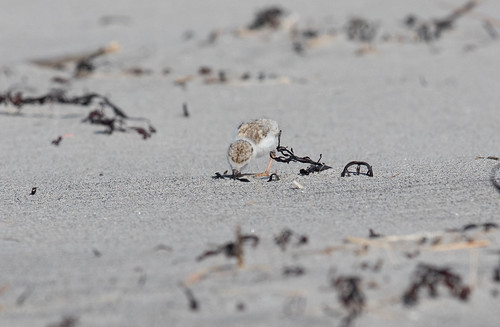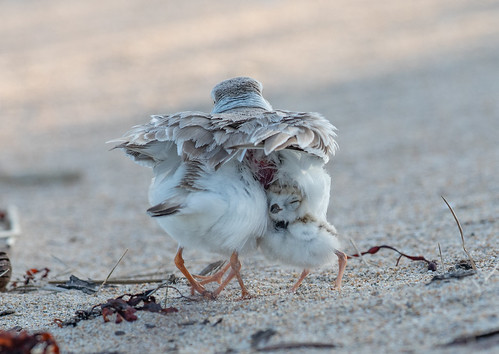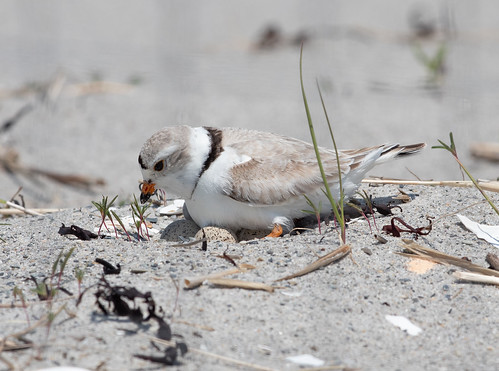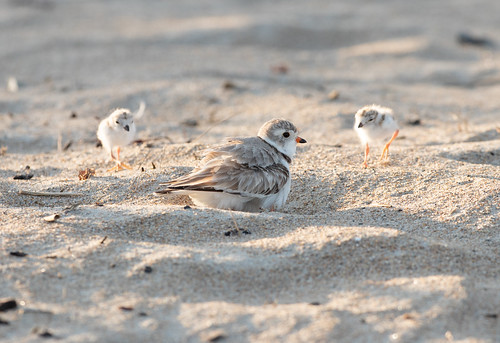We almost entirely reserve the use of the word warmth for expressing love or kindness. We wouldn’t refer to a warm touch as cruel even though hands that injure tend to be pretty much the same body temperature as hands that nurture. Most of us were at least occasionally held close to a warm body as babies, and although we can’t remember that, we retain a visceral sense of nurturing warmth. The only synonyms Microsoft Word gave me when I looked up the word warm are sincere, heartfelt, deep, earnest, wholehearted, kind, and warmhearted. We know without question that a beating heart is a warm heart, at least when it beats within a warm-blooded animal, including a human being.
I couldn’t help but think of the warmth of love on June 3, when for the first time in my life I got to see baby Piping Plovers—one- or two-day old chicks scurrying about on Maine beaches. Each plover pair produces four eggs which hold wondrously still in the nest until one fine day, when they hatch into four tiny fluff balls of Brownian motion, running helter-skelter over the beach until a magnetic force draws them suddenly back to a mother or father. They crowd against that warm body to rest and warm up before running off again.
Mammal mothers, by the animal class's very definition, nurse their young. Most bird parents feed their young, but plovers don't. The precocial chicks are fully capable of finding food and eating it from the start, even as just like baby mammals and most baby birds, they rely on parental warmth until they are fully capable of maintaining their own body temperature two or three weeks after hatching.
 |
| Even as newly hatched chicks, Piping Plovers find and eat food on their own, but still need parental warmth. |
Most birds maintain a body temperature of somewhere between 104- and 110-degrees Fahrenheit, and the lack of feathers on that vascularized tissue where the chick will rest its head ensures that there is no barrier between the mother or father’s inner heat and the exact place where the tiny chick needs it the most. A couple of my photos show both a parent’s vascularized skin and the look of contentment on the chick nestled in there. Some people would charge that the word contentment is anthropomorphic—that we have no idea whether little plovers can feel contentment at all—but imagining that they are incapable of an elemental emotion like contentment as they snuggle into a warm parent is bizarrely anthropocentric and unscientific.
My photos also show how the feathers on the adult’s sides droop down to help further insulate the babies.
As two, three, or four babies burrow in, when the parent sees that any babies who want in are accounted for, he or she closes the wings and hunkers down.
The only thing more charming than seeing what looks like a four-, six-, eight-, or ten-legged plover is seeing it while the wings are still open, giving us a glimpse at one or two chicks’ faces as they snuggle in.
People tend to think of love as a uniquely human emotion, but that baffles me. When a woman harms her baby due to postpartum depression, we understand that as a hormonal imbalance, but have a harder time seeing a woman’s proper nurturing behavior as hormonal and instinctive, and hardly ever realize a father’s bonding with his young is also hormonally influenced and instinctive. The gush of love that I felt as a nursing mother was part of what kept me focused on properly caring for my babies—clearly an evolutionary advantage that fostered survival of my young. Why can’t we allow that same gush of feeling within a Piping Plover parent, opening his or her wings to and sharing body warmth with plover chicks?
Our human DNA and biochemistry are surprisingly close to that of birds, other mammals, and even what we prefer to think of as lower animals. And as creatures all living on earth at the same time, we all have the same length of evolutionary history. We share more with Piping Plovers than many people care to admit, and it seems profoundly unscientific to believe that somehow, despite millions of years of evolution, we humans magically developed a monopoly on love and contentment unique in all the animal kingdom. Parents of many species provide a warm and comforting presence to their young, and when it comes down to it, that’s what love is all about.













